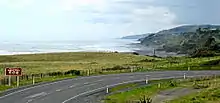Mōkau | |
|---|---|
Village | |
 Mōkau panorama: river, SH3 bridge, beach - and Mt. Taranaki far away (82km = 51mi) in the background | |
| Coordinates: 38°41′S 174°37′E / 38.683°S 174.617°E | |
| Country | New Zealand |
| Region | Waikato region |
| District | Waitomo District |
| Ward | Waitomo Rural Ward |
| Electorates | |
| Government | |
| • Territorial Authority | Waitomo District Council |
| • Regional council | Waikato Regional Council |
| Area | |
| • Territorial | 19.82 km2 (7.65 sq mi) |
| Population (June 2023)[2] | |
| • Territorial | 100 |
| • Density | 5.0/km2 (13/sq mi) |
| Time zone | UTC+12 (NZST) |
| • Summer (DST) | UTC+13 (NZDT) |
Mōkau is a small town on the west coast of New Zealand's North Island, located at the mouth of the Mōkau River on the North Taranaki Bight. Mōkau is in the Waitomo District and Waikato region local government areas, just north of the boundary with the New Plymouth District and the Taranaki Region. Prior to 1989, the town was classed as being in Taranaki, and there is still a feeling that the community of interest is most associated with New Plymouth, 90 km to the southwest.[3] State Highway 3 passes through the town on its route from Te Kūiti to Waitara and, eventually, New Plymouth.
The Mōkau River Bridge opened in 1927.[4]
Mōkau is a popular location for whitebaiting and other fishing including for kahawai (mainly found at the river mouth) and snapper (which are found right along the coast in several spots).
Mōkau also has a couple of outstanding surf breaks that, in the right conditions, can produce waves of up to 6 ft (1.8m).
The local marae, Te Kawau Papakainga Marae and Waiopapa meeting house, are affiliated with the Ngāti Maniapoto hapū of Ngāti Rākei, Rōrā and Rungaterangi.[5][6]
Demographics
Statistics New Zealand describes Mōkau as a rural settlement, which covers 19.82 km2 (7.65 sq mi)[1] and had an estimated population of 100 as of June 2023,[2] with a population density of 5.0 people per km2. The settlement is part of the larger Herangi statistical area.[7]
| Year | Pop. | ±% p.a. |
|---|---|---|
| 2006 | 129 | — |
| 2013 | 108 | −2.51% |
| 2018 | 117 | +1.61% |
| Source: [8] | ||

Mōkau had a population of 117 at the 2018 New Zealand census, an increase of 9 people (8.3%) since the 2013 census, and a decrease of 12 people (−9.3%) since the 2006 census. There were 66 households, comprising 60 males and 57 females, giving a sex ratio of 1.05 males per female. The median age was 58.9 years (compared with 37.4 years nationally), with 6 people (5.1%) aged under 15 years, 12 (10.3%) aged 15 to 29, 57 (48.7%) aged 30 to 64, and 39 (33.3%) aged 65 or older.
Ethnicities were 84.6% European/Pākehā, 23.1% Māori, 2.6% Asian, and 2.6% other ethnicities. People may identify with more than one ethnicity.
Although some people chose not to answer the census's question about religious affiliation, 51.3% had no religion, 35.9% were Christian, and 2.6% had Māori religious beliefs.
Of those at least 15 years old, 3 (2.7%) people had a bachelor's or higher degree, and 42 (37.8%) people had no formal qualifications. The median income was $22,000, compared with $31,800 nationally. 6 people (5.4%) earned over $70,000 compared to 17.2% nationally. The employment status of those at least 15 was that 42 (37.8%) people were employed full-time, 15 (13.5%) were part-time, and 3 (2.7%) were unemployed.[8]
Education
Mōkau School is a co-educational state primary school,[9] with a roll of 30 as of April 2023.[10][11]
Museum and art gallery
Mōkau has a small community museum and art gallery.[12]
References
- 1 2 "ArcGIS Web Application". statsnz.maps.arcgis.com. Retrieved 6 November 2022.
- 1 2 "Subnational population estimates (RC, SA2), by age and sex, at 30 June 1996-2023 (2023 boundaries)". Statistics New Zealand. Retrieved 25 October 2023. (regional councils); "Subnational population estimates (TA, SA2), by age and sex, at 30 June 1996-2023 (2023 boundaries)". Statistics New Zealand. Retrieved 25 October 2023. (territorial authorities); "Subnational population estimates (urban rural), by age and sex, at 30 June 1996-2023 (2023 boundaries)". Statistics New Zealand. Retrieved 25 October 2023. (urban areas)
- ↑ McKinlay Douglas Ltd (October 2006). "Local government structure and efficiency" (PDF). p. 79.
- ↑ Auckland Weekly News photo of 1927 opening of Mokau River Bridge
- ↑ "Te Kāhui Māngai directory". tkm.govt.nz. Te Puni Kōkiri.
- ↑ "Māori Maps". maorimaps.com. Te Potiki National Trust.
- ↑ 2018 Census place summary: Herangi
- 1 2 "Statistical area 1 dataset for 2018 Census". Statistics New Zealand. March 2020. 7013195.
- ↑ "Ministry of Education School Profile". educationcounts.govt.nz. Ministry of Education.
- ↑ "New Zealand Schools Directory". New Zealand Ministry of Education. Retrieved 12 December 2022.
- ↑ "Education Review Office Report". ero.govt.nz. Education Review Office.
- ↑ "About Us". Mokau Museum and Gallery. Retrieved 3 October 2023.